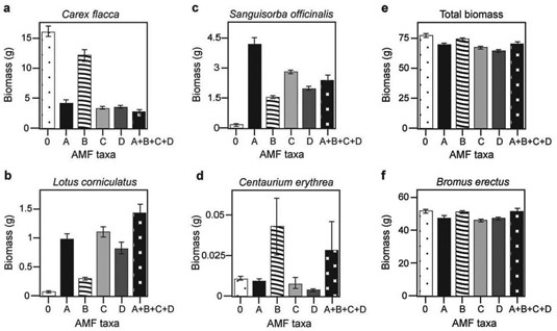Multiple Choice
Use the following information to answer the question(s) below.
Canadian and Swiss researchers wanted to know if the diversity of arbuscular mycorrhizal fungi (AMF) was important to the productivity of grasslands (M.G.A. van der Heijden, J. N. Klironomos, M. Ursic, P. Moutoglis, R. Streitwolf-Engel, T. Boler, A. Wiemken, and I. R. Sanders. 1998. Mycorrhizal fungal diversity determines plant biodiversity, ecosystem variability and productivity. Nature 396:69-72) . Specifically, they wanted to know if it mattered which specific AMF species were present, or just that some type of AMF was present. They grew various plants in combination with one of four AMF species (A, B, C, and D) , no AMF species (O) , or all four AMF species together (A + B + C + D) ; and they measured plant growth under each set of conditions. All plant species were grown in each plot, so they always competed with each other with the only difference being which AMF species were present.
On the graphs below, the x-axis labels indicate the number and identity of AMF species (bar 0 = no fungi; bars A-D = individual AMF species; bar A + B + C + D = all AMF species together) . The y-axis indicates the amount (grams) of plant biomass for the species shown in italics above each graph. Graph (e) is the total biomass (grams) of all 11 plant species combined; graph (f) is the biomass of Bromus erectus plants only, separated from the total. 
-Based on the graphs in the accompanying figure, which of the following plant species is most likely NOT to form mycorrhizal associations?
A) Carex flacca (graph a)
B) Lotus corniculatus (graph b)
C) Sanguisorba officinalis (graph c)
D) Centaurium erythrea (graph d)
Correct Answer:

Verified
Correct Answer:
Verified
Q19: Lichens are symbiotic associations of fungi and
Q21: Many amphibian populations have been decimated by
Q22: Which of the following is an important
Q22: The adaptive advantage associated with the filamentous
Q23: The sporangia of the bread mold Rhizopus
Q23: When a mycelium infiltrates an unexploited source
Q25: Some fungal species can kill herbivores while
Q27: Microsporidians are considered parasitic because of the
Q28: Which of the following terms refers to
Q29: All fungi are _.<br>A) symbiotic<br>B) heterotrophic<br>C) flagellated<br>D)